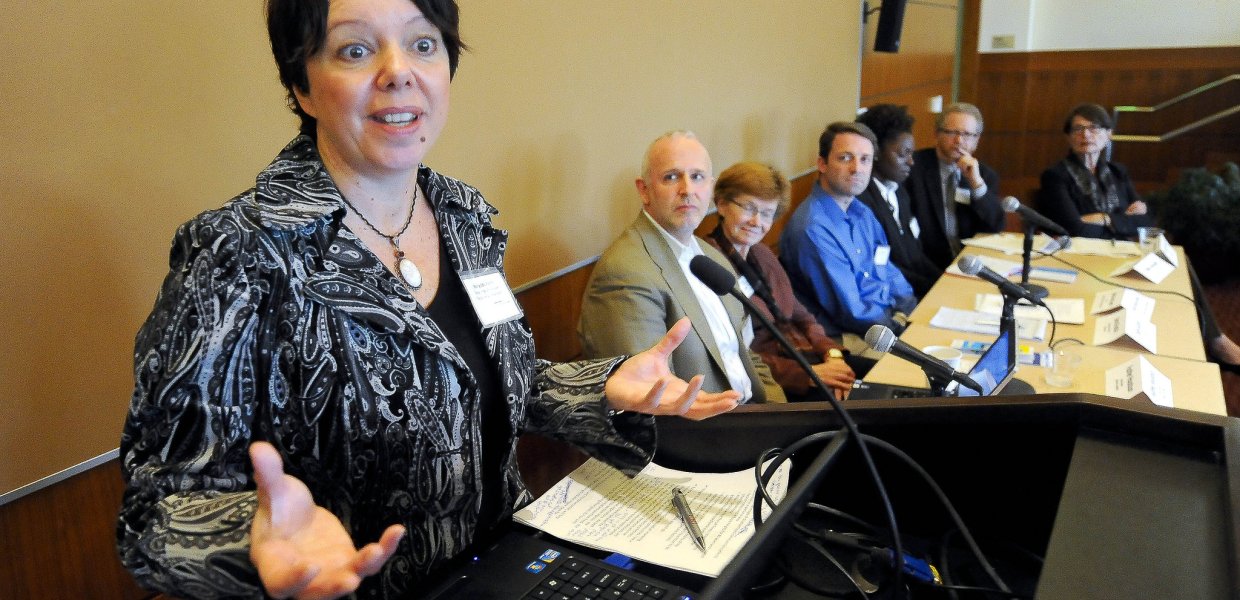USC Annenberg's Dec. 4 conference on "Expanding Coverage: News and Information to Enhance Community Health" brought together media and non-profit leaders to find ways to better engage and serve marginalized communities
West Virginians are suffering through an obesity epidemic with some of the nation’s worst statistics when it comes to chronic diseases such as obesity, diabetes, heart attacks and high blood pressure.
This particular epidemic raged with little public awareness or broader policy action, in part because the topic was sometimes considered too impolite to discuss. That has changed, thanks to West Virginia’s leading newspaper; freelance journalist Kate Long; The California Endowment; and the USC Annenberg School for Communication and Journalism.
Long is a 2011 grant recipient of the Dennis A. Hunt Fund for Health Journalism, a project of USC Annenberg’s California Endowment Health Journalism Fellowships. On Dec. 4-5, she joined dozens of distinguished journalists and representatives from some of the leading foundations that fund journalism and community health for a USC Annenberg conference on “Expanding Coverage: News and Information to Enhance Community Health.”
Speaking as part of a conference panel titled “Journalism with Impact,” Long told those assembled about the 45 articles that The Charleston Gazette has published concerning obesity and related topics since she began her coverage, which she said aimed to create a state of “sustained outrage” among the public and policy makers.
“The paper couldn’t have done it without the Hunt Fellowship and we are very grateful for it,” Long said.
Michelle Levander, founding director of The California Endowment Health Journalism Fellowships, said this conference differed from her group’s traditional focus – providing health journalism training to more than 500 journalists they have brought to USC Annenberg since 2005, as well as ongoing mentoring on Fellowship projects and journalism grantmaking.
“This is definitely a departure for us, a new kind of event,” Levander said. “But I think it’s a natural extension of some of the questions that have come up from our work. We have become, on a much smaller scale, a supporter of journalism – particularly journalism of underserved communities – with these mini-grants.”
The conference began with remarks by Levander, Dean Ernest J. Wilson III, School of Journalism Director Geneva Overholser and The California Endowment President and Chief Executive Officer Robert K. Ross.
Levander further described the aims of the gathering in a blog post she wrote for the group’s Reporting on Health website prior to the gathering.
She wrote: “Our symposium explores the critical role of media in engaging with and serving marginalized communities. We will learn about creative storytelling approaches, including many supported by philanthropies that give community members a greater voice in civic life.”
In a “Journalism with Impact” session, Jessica Pérez and Brizette Castellanos of Boyle Heights Beat, spoke of their media experiences. Boyle Heights Beat is a California Endowment-funded bilingual quarterly newspaper and joint project of USC Annenberg and La Opinion, the Spanish-language daily.
Pérez asked the 16-year-old Castellanos how she thought her neighborhood had previously been portrayed by media.
“Like a typical low-income community,” Castellanos said, “Boyle Heights was perceived as dangerous, a bad area to live in, a failure. Basically: ‘Nothing good comes out of a community like that.’”
Pérez asked how Castellanos felt now, having recently published her first article and announcing at the conference – to much applause – that she wanted to become a professional journalist. “I get to show the good side of Boyle Heights,” Castellanos said. “I value the paper because of that.”
Mary Lou Fulton, senior program manager at The California Endowment, moderated the conference’s closing panel titled “Foundation-Funded Journalism: Promise and Peril.”
“Too many people are invisible,” Fulton said about underserved areas. “The power of story is a way for us to build understanding and build empathy and open connections in communities we don’t know.”
Mark Jurkowitz, associate director of the Pew Research Center’s Project for Excellence in Journalism, shared preliminary findings of a report his organization is working on regarding the financial underpinning of the non-profit media sector.
Jurkowitz said he knew of about 24 media non-profits that had recently gone out of business. Many others, he said, are living day-to-day with minimal resources.
“What are some of the broad things we are learning about the sector?” he asked. “It is robust and it is fragile.”
In a following Q-and-A session, top editors from publications such as the Seattle Times and Texas Tribune were among those making strong statements or asking tough questions about funding.
“One of the things that was quite palpable towards the end, as the media people in the room were talking to these very powerful national media foundations,” Levander said, “was a feeling of frustration with, ‘How do we figure out what’s the ‘magic formula?’”
“This was countered,” she said, “by the reality confronting these media foundations: That as worthy as these projects are, they can’t fund them all.”
Then again, learning first-hand about the work being done by the conference attendees and listening to them share ideas and best practices about community health journalism left many in the room feeling buoyed.
“Today has been an absolutely astounding day for me,” said Mark Hallett, senior program officer of the Chicago-based Robert R. McCormick Foundation, a longtime media grantmaker. “The range of work that is being done here in the region is really phenomenal. I’ve just been soaking it up.”






